Trying to find storage solutions that truly work can feel like a never-ending project, especially if your home is small or you just have a lot of stuff. After working with hundreds of homes over the years, I’ve realized the most successful storage ideas mix practicality and style.
Remember to repin your favorite images!
The best storage solutions don’t just keep things organized—they make your space feel better and less cluttered.
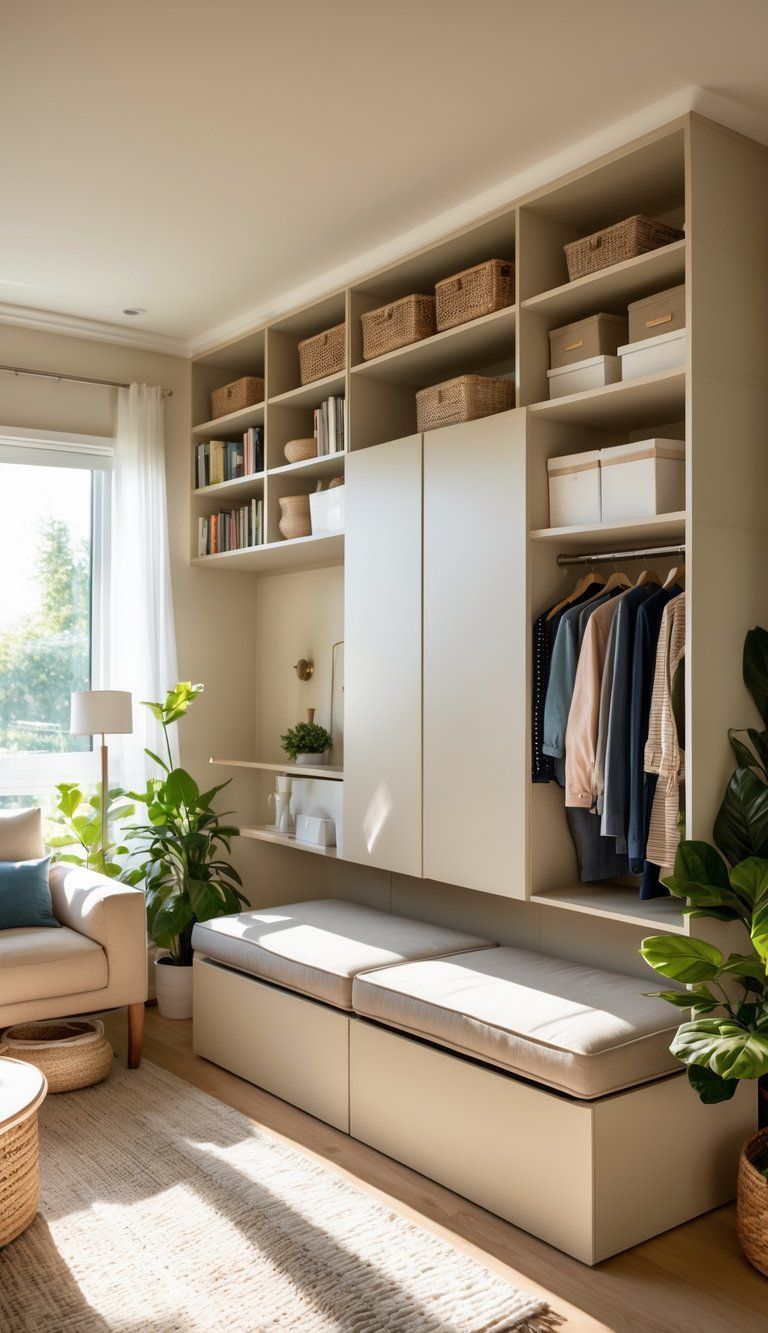
Kitchen pull-out pantry systems and sneaky storage in wall studs can totally change how you use your space. Most people don’t realize they’ve got storage goldmines in places like the 14-16 inch gaps between wall studs or in furniture that does double duty.
Options like storage baskets, wall shelves, and multipurpose furniture can quickly make your home feel more functional. The trick is picking solutions that actually fit your lifestyle and habits.
When storage matches the way you live, it’s way easier to keep things organized for the long haul.
Understanding Common Storage Challenges
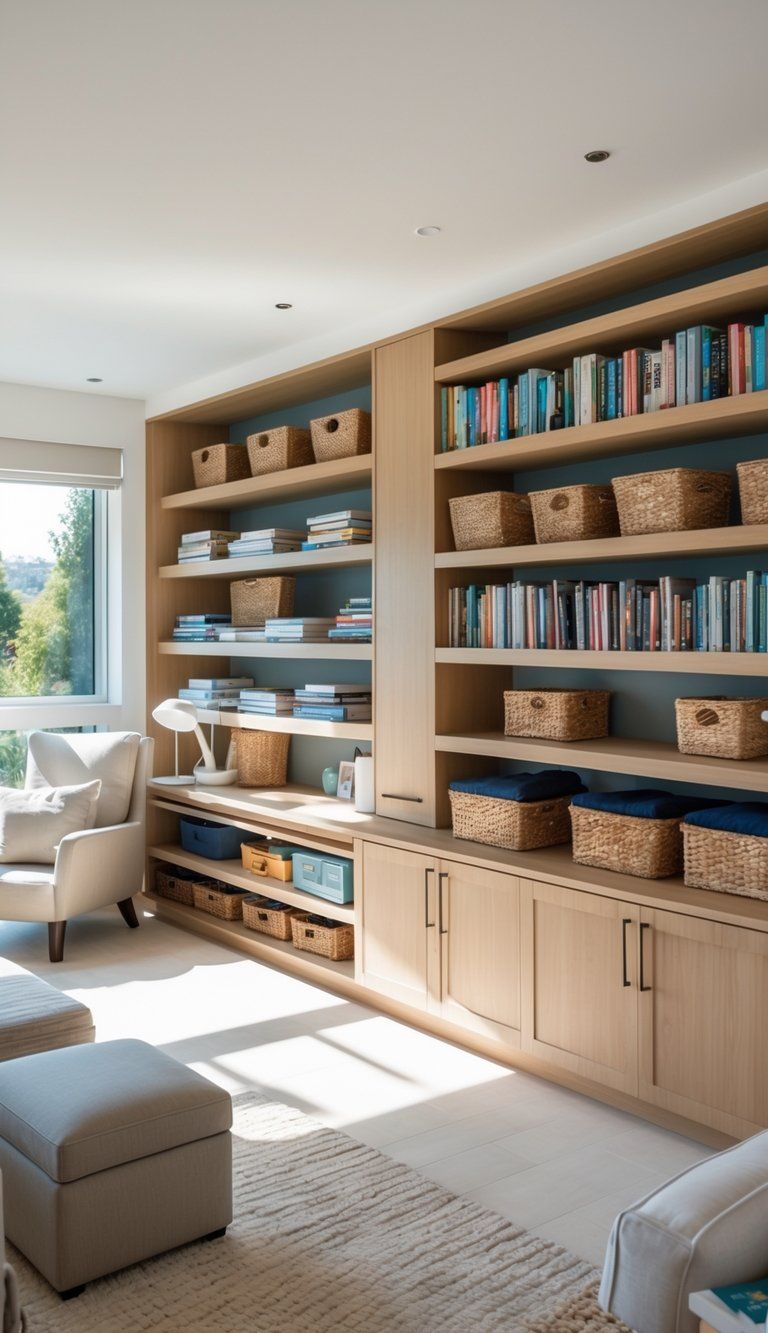
Almost every home runs into similar storage headaches, no matter the size or layout. To find the right fixes, you first need to figure out what’s not working and why your stuff keeps piling up.
Typical Storage Issues in Real Homes
Clutter creeps in slowly in most households. When items don’t have designated homes, chaos takes over and rooms feel smaller.
We all have that “junk drawer” where random stuff just collects. It’s universal.
Seasonal things like holiday decorations and winter coats can be a pain to store—they’re used rarely but hog a lot of space.
Older homes especially tend to have not enough closet space, since people just didn’t own as much back then.
Entryways often become dumping grounds for mail, keys, shoes, and bags if there’s no system in place.
Overcoming Limited Space
If you’re short on room, vertical storage is your best bet. Try shelves that reach up to the ceiling and make use of that empty wall space.
Furniture that serves more than one purpose is a game changer—think ottomans with hidden storage, beds with drawers underneath, or coffee tables that lift open.
People often forget about the backs of doors. Over-the-door organizers can hold shoes, cleaning supplies, or pantry stuff depending on the room.
Check out “dead zones” like space above kitchen cabinets or under the stairs. You can turn these forgotten areas into real storage.
Space-saving tip: Vacuum storage bags shrink bulky bedding and out-of-season clothes down by up to 75%. Super handy.
Tailoring Solutions to Lifestyle Needs
Your storage needs shift based on your daily routine. If you work from home, you’ll want a spot for office supplies and tech.
Families with kids need storage that’s easy for little hands. Bins at kid-height and color coding make cleanup less of a battle.
If you’re into hobbies, you’ll need storage that fits your stuff. Crafters need small organizers while sports gear needs tough, easy-access bins.
Try the “one in, one out” rule if you struggle with decluttering. It helps keep things balanced.
Set up zones based on activity—keep cooking stuff near the stove, mail by the door, and laundry supplies close to the washer. It just makes life easier.
Decluttering as a Foundation for Effective Storage

Before you spend money on storage, clear out what you don’t need. Honestly, decluttering is the only way to make space for systems that actually work.
It’s not just about tossing stuff—it’s about making room for a home that fits your real life.
Streamlining Possessions Before Organizing
The best storage systems start with less stuff. Go room by room and decide what to keep, donate, or toss.
Start with clothes in the bedroom. They’re usually the biggest clutter culprit. Ask yourself, “Did I wear this in the last year?” If not, maybe it’s time to let it go.
Set clear decluttering goals. Professional organizer Ashley Hines always says to figure out your “why”—maybe you want to save time, lower stress, or just breathe easier at home.
Sort into three piles:
- Keep: Stuff you use and love
- Donate/Sell: Good condition, but you don’t need it
- Trash/Recycle: Damaged or unusable
Practical Decluttering Tips That Last
Work in short bursts—15 to 30 minutes at a time. That way, you won’t get overwhelmed and give up halfway through.
Stick with the “one in, one out” rule to keep clutter in check. If something new comes in, something old has to go.
Start with high-traffic spots like entryways and kitchen counters. A quick win here makes your whole home feel better.
After decluttering, use vertical storage like floating shelves and wall hooks. They don’t take up floor space and keep things you use often close by.
Don’t just hide clutter in bins! Only buy storage after you’ve pared down, or you’ll end up with organized chaos instead of a system that works.
Smart Storage Solutions for Small Spaces
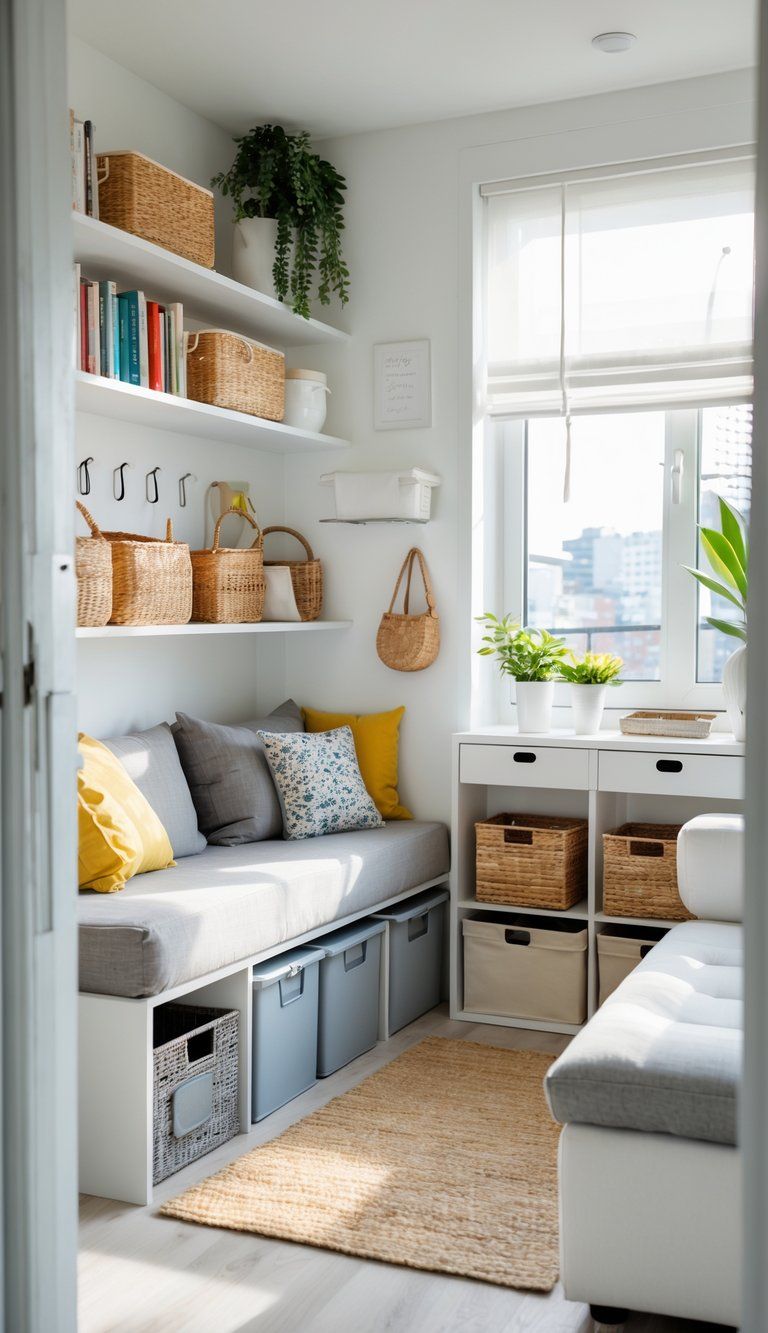
Living in a small home doesn’t mean you’re doomed to clutter. You just have to get creative and work with what you’ve got.
Utilizing Vertical Space to Maximize Capacity
When you’re short on floor space, look up! Vertical storage is usually the most ignored trick in small homes.
Install tall bookcases or shelving units to stash books, decor, and storage boxes. You get more storage without using up precious floor space.
Wall-mounted shelves, pegboards, and rail systems can hold everything from kitchen utensils to office supplies. In the kitchen, magnetic knife strips and hanging pot racks free up drawers and cabinets.
Don’t ignore the space above doors and windows. Shallow shelves here are great for displaying collections or stashing things you don’t use often.
Stackable containers help you build up, not out. Clear boxes are best—you can see what’s inside without opening everything.
Making Use of Corners and Awkward Areas
Corners are usually wasted, but they can actually hold a lot. Corner shelves turn awkward spots into useful storage for books, plants, or decor.
In the kitchen, corner cabinet organizers like lazy Susans make deep cabinets less of a black hole. For bathrooms, try triangular shelves or corner caddies.
There’s also furniture made just for corners:
- Corner desks
- Corner TV stands
- L-shaped seating with storage underneath
Hallway nooks or spaces between windows can fit custom shelves or slim furniture. Under the stairs? That’s prime storage real estate—think drawers or open shelves.
Room dividers with shelves can split up space and add storage at the same time.
Adapting to Unconventional Layouts
Weird layouts need some outside-the-box thinking. Custom solutions often work best for odd-shaped rooms or strange architectural quirks.
Go for furniture that multitasks:
- Storage benches
- Beds with drawers
- Coffee tables with hidden spots
- Dining tables with shelves or leaves
You can sneak storage into places like toe-kick drawers under kitchen cabinets or stair risers. Hollow ottoman tops are perfect for hiding blankets or remotes.
Furniture that adapts to you is a smart move. Murphy beds fold away for more space during the day, and some even have built-in desks or shelves. Expandable tables can grow for guests and shrink when you’re on your own.
Rolling carts are a lifesaver if your space needs to do double duty. Move them around as needed and stash them away when you’re done.
Hidden Storage Opportunities in Every Room
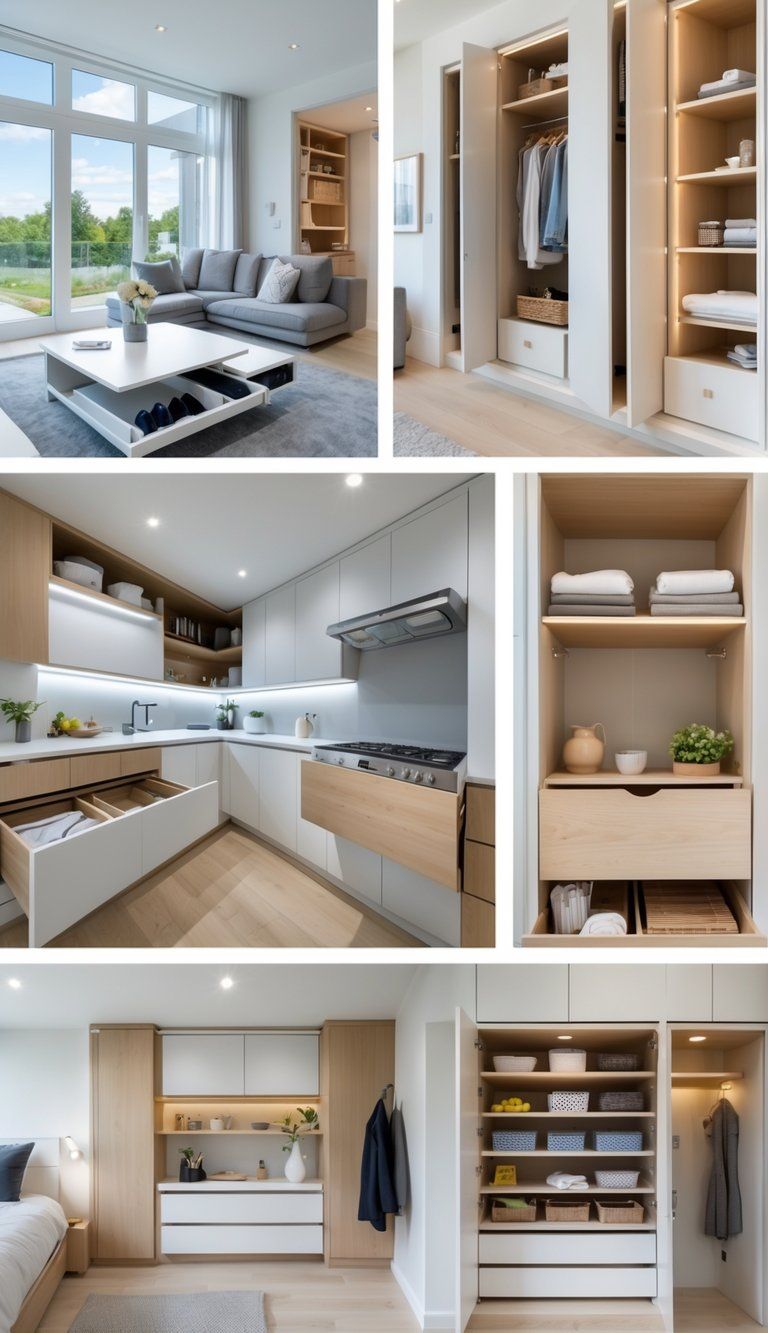
Every room hides storage potential—you just have to spot it. Finding those sneaky spots helps you stay organized without adding bulky furniture or losing style.
Creative Under-Bed Storage Options
Under the bed is a storage goldmine. Low-profile bins with wheels make it easy to pull out seasonal clothes or extra blankets. Clear lids mean you don’t have to open every bin to find what you need.
Bed frames with built-in drawers look tidy and keep your stuff hidden. No need for extra containers.
If you have a platform bed, measure the space underneath and get storage that fits perfectly. Vacuum bags are great for shrinking bulky winter gear.
Pro tip: Drawer dividers inside under-bed bins keep small stuff from disappearing into the abyss.
Making the Most of Wall and Ceiling Space
Walls can hold a ton without crowding your floors. Floating shelves add storage and give rooms some personality. Try putting them above doors or windows to use every inch.
Wall-mounted cabinets with doors hide clutter and keep things neat. In kitchens, run cabinets all the way to the ceiling for bonus storage.
Ceilings, especially in garages or basements, can hold overhead racks for seasonal stuff or luggage.
In living rooms, pick furniture with secret storage—coffee tables with hidden spots or ottomans that open up. These pieces do double duty and help your space feel less cramped.
Multi-Functional and Dual-Purpose Furniture
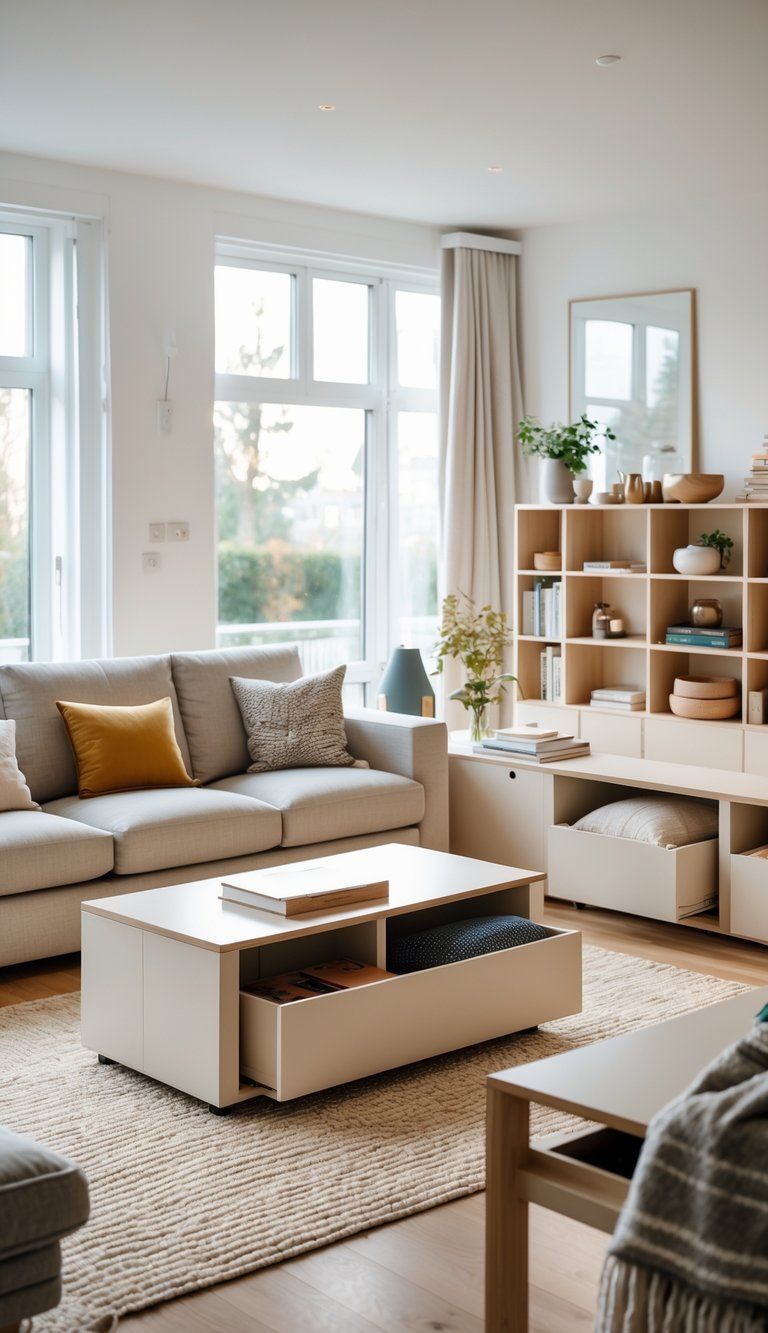
Furniture that pulls double (or triple) duty is the real secret to getting the most from your space. These pieces fight clutter and look good while they’re at it.
Storage Ottomans and Benches
Storage ottomans are total MVPs. They’re footrests, extra seats, and hidden storage all rolled into one. Pick ones with sturdy lids that stay open when you need to grab something.
Put a storage ottoman in your living room to stash blankets, magazines, or remotes. In the bedroom, they fit perfectly at the foot of the bed for extra linens or off-season clothes.
Storage benches work wonders in entryways. Sit down to put on shoes, then lift the seat to hide boots or bags. Some even have cubbies or hooks for more organization.
Go for washable fabrics if you can—leather and performance fabrics are easy to clean and stand up to daily messes.
Transforming Tables and Murphy Beds
Transforming tables change with your needs. Coffee tables that lift to dining height are lifesavers in small spaces. Some even hide dinnerware or your laptop inside.
Nesting tables tuck away when you don’t need them and spread out for guests. Wall-mounted drop-leaf tables fold up flat, freeing up floor space in seconds.
Murphy beds (wall beds) are a classic for studio apartments or guest rooms. Newer models fold away smoothly and often have built-in shelves or even a desk.
Some designs combine a desk with a bed—work by day, sleep by night, all in the same spot. Look for sturdy hardware so everything keeps working smoothly year after year.
Custom and Built-In Storage Solutions
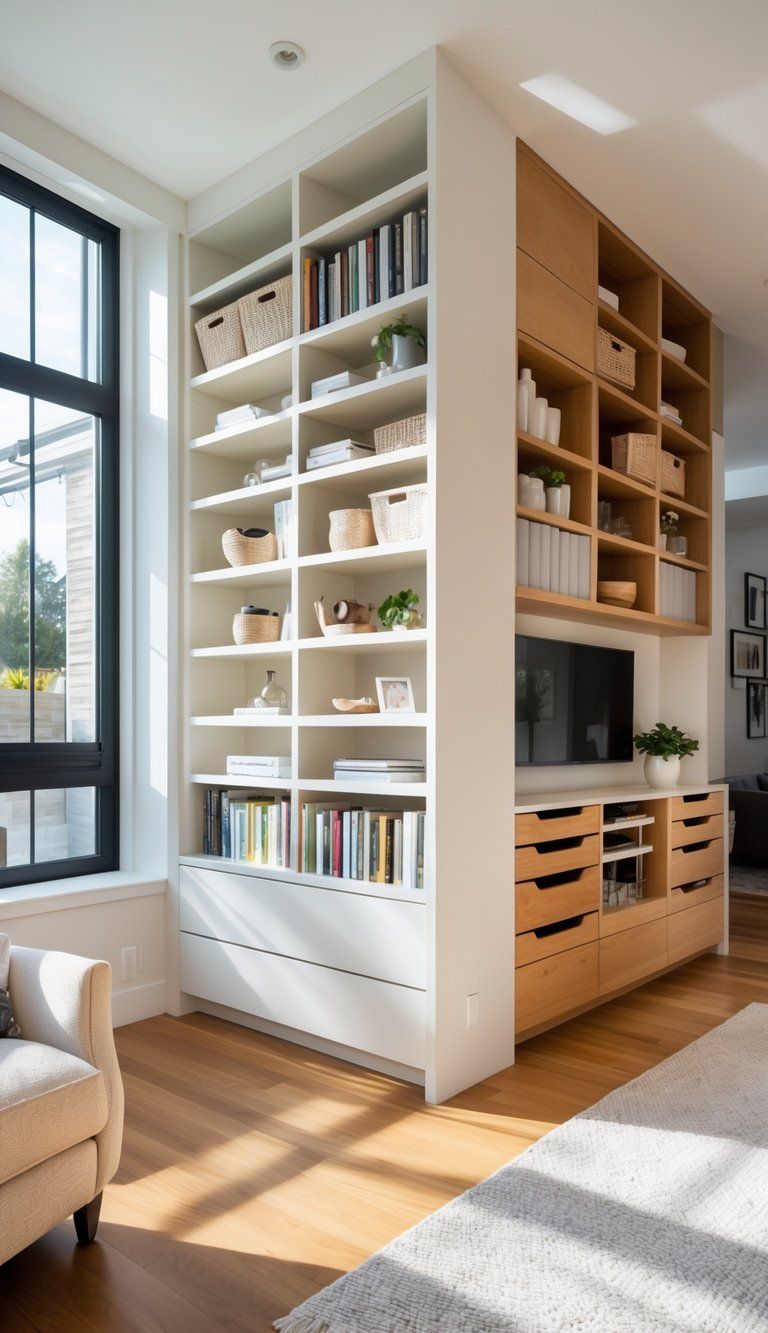
Custom storage can turn dead zones in your home into useful, valuable spaces. Built-in options usually give you about 40% more storage than regular furniture, and they often cost less per cubic foot.
Built-In Cabinets and Shelving
Built-in cabinets and shelves give your home a sleek, seamless vibe. They also make the most of every inch, especially in tricky corners or weirdly-shaped walls.
Under the stairs? Most people ignore that spot. You can turn it into pull-out drawers, compact cabinets, or even open shelving for books and display pieces.
Window seats with hidden storage pull double duty. They offer a cozy place to sit and stash away bedding or off-season stuff. In the living room, built-in entertainment centers keep cords and electronics out of sight.
Kitchens and dining rooms get a boost from custom wine racks or stemware slots. These features protect delicate items and make entertaining easier.
Floor-to-Ceiling Installations
Floor-to-ceiling storage lets you use every bit of vertical space, which is a lifesaver in small homes or apartments. These tall setups draw your eyes up and make rooms feel bigger.
In bedrooms, floor-to-ceiling wardrobes can replace bulky dressers and clear up floor space. Mix hanging rods, drawers, and shelves to fit all your clothes.
Full-height bookshelves in living spaces become instant focal points and hold tons of books, photos, and keepsakes. If you want, add a rolling ladder for those hard-to-reach shelves.
Home offices can use wall-to-wall desks with cabinets above. This keeps supplies organized without crowding your desk.
Try adding push-to-open cabinets in tall installations. When closed, they blend right in with the wall.
Optimizing Living Room Storage
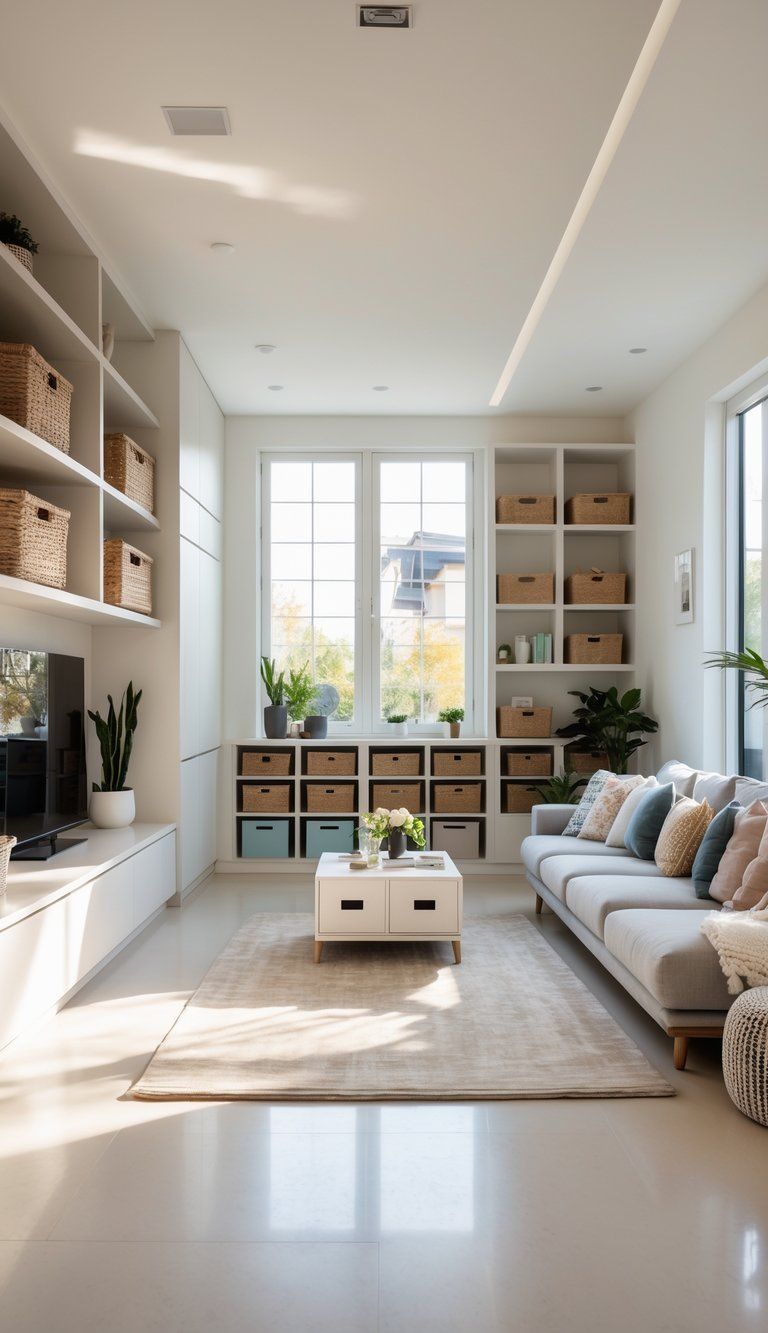
Living rooms need smart storage that hides clutter but keeps daily essentials handy. The right setup can turn chaos into calm, and you don’t have to give up style to do it.
Concealed Storage for Everyday Use
Hidden storage helps your living room look tidy and keeps the things you use most within reach. Go for furniture with secret compartments, like ottomans that pop open for blankets or magazines.
Walls are valuable real estate. Install floating shelves up high for books and decor—this lifts your gaze and frees up the floor.
Benches under windows with lift-up seats are perfect for hiding toys, games, or seasonal stuff. You get a place to sit and a spot to stash things.
Side tables with drawers or cabinets beat plain tables any day. They corral remotes, coasters, and all those little things that love to clutter up a room.
Incorporating Storage Furniture
Choose furniture that does more than one job. Storage benches can serve as coffee tables, extra seats, and sneaky spots for blankets or board games.
Bookcases don’t have to be boring or all open. Pick ones with both shelves and cabinets. Show off your favorite things and hide the rest.
Media consoles with adjustable shelves let you change things up as you need. Look for built-in cable management to keep cords out of sight.
Furniture with charging stations for your devices is a game-changer. No more cord mess, and you always know where your phone is.
Room dividers with shelves can split up open spaces and add more storage for books or decor.
Maximizing Kitchen Storage
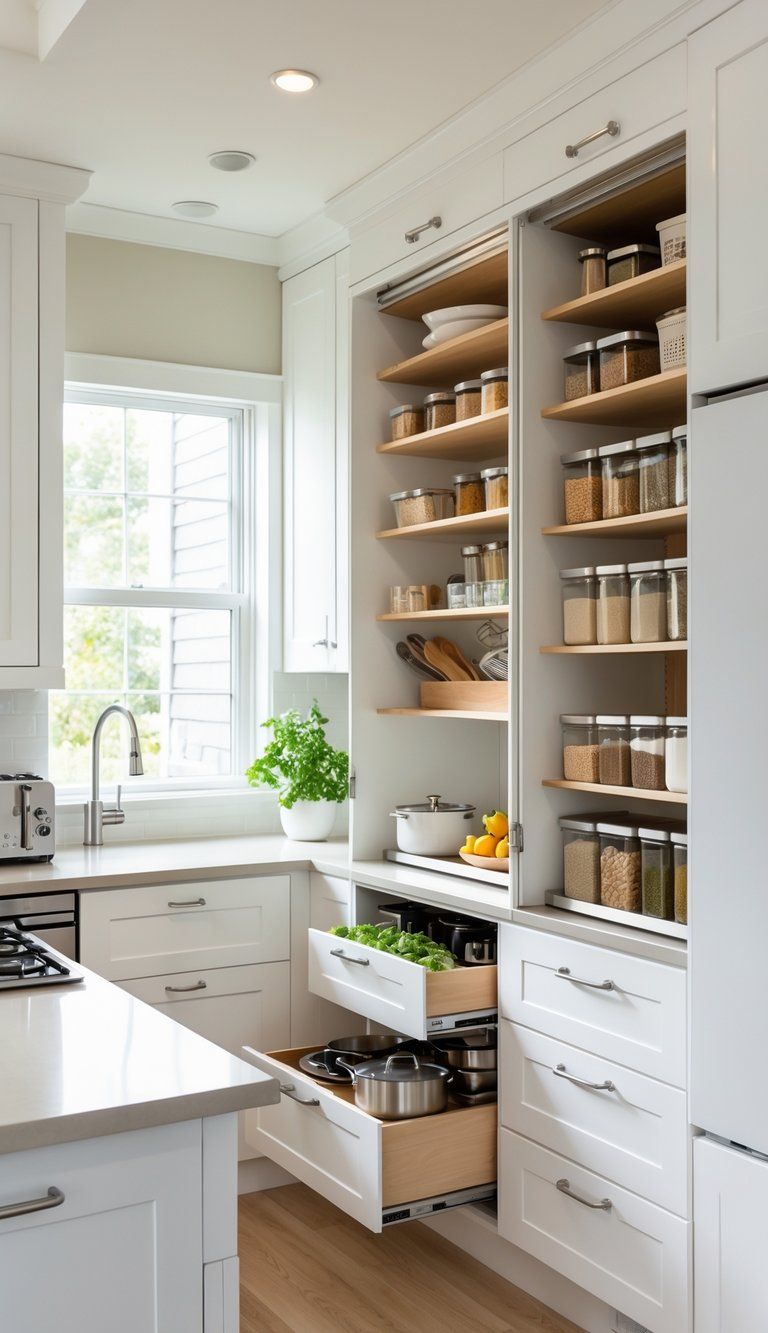
Kitchens fill up fast with cookware, gadgets, and food. Smart storage can make even tiny kitchens feel organized and easy to use.
Clever Cabinet Door Organizers
Cabinet doors are often wasted space. Mount slim organizers inside them for spices, cutting boards, or cleaning supplies.
Wire racks or clear holders are great for spices. They keep everything easy to see and grab while you cook.
Try pull-out racks on under-sink doors for spray bottles and sponges. This keeps supplies organized and stops them from getting lost in the back.
Attach magnetic strips to cabinet doors for knives or metal utensils. If you’re short on drawer space, this trick is a lifesaver.
Open Shelving and Pegboard Systems
Open shelving turns kitchen storage into a feature. Show off pretty dishes or colorful cookware and make more space at the same time.
When you install open shelves:
- Put things you use often on the lower shelves
- Place decorative pieces at eye level
- Keep heavy stuff on sturdy shelves
Pegboards are super flexible for kitchen storage. Hang pots, pans, utensils, or tools right where you need them.
Try color-coding or making zones on your pegboard. It makes finding things fast, and you can change it up anytime.
Mix pegboards with small shelves or baskets for stuff that doesn’t hang. You’ll get a wall of storage that keeps essentials close and the counters clear.
Efficient Bathroom Storage Ideas
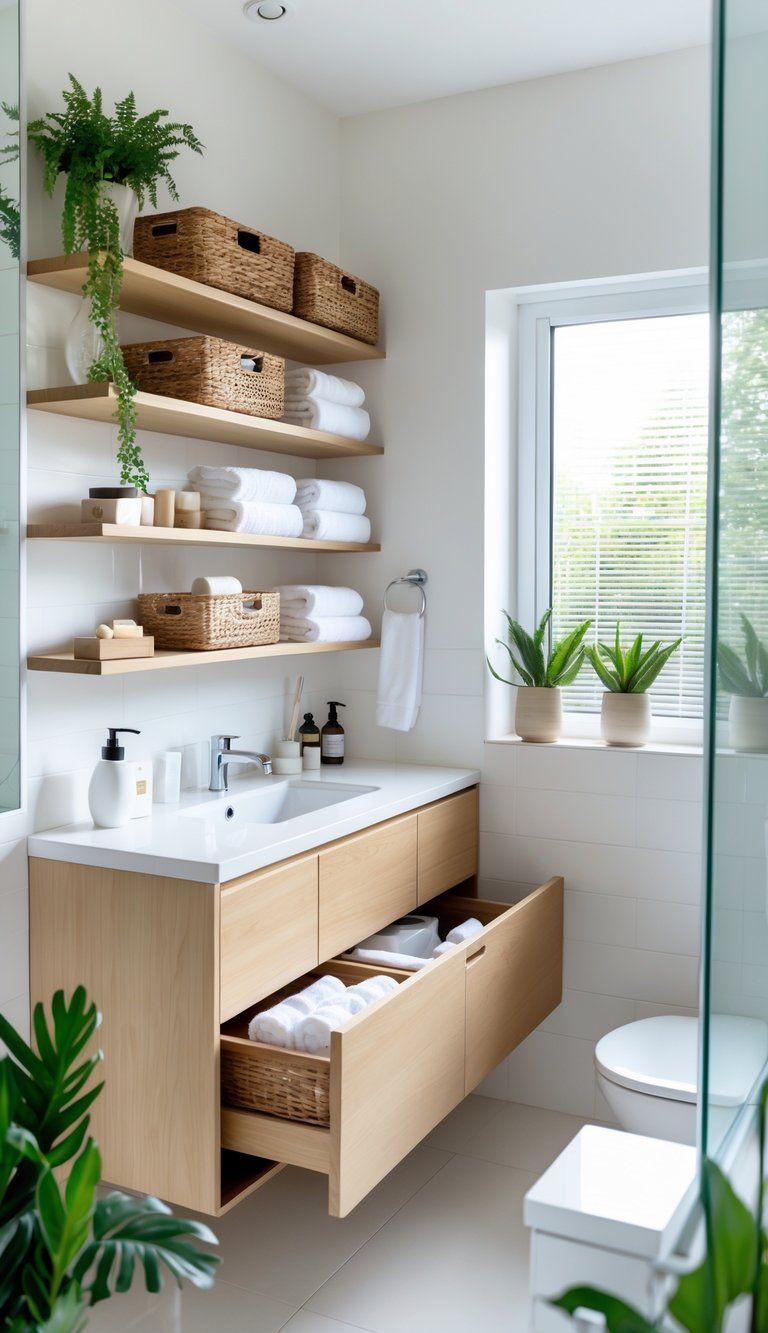
Bathrooms fill up with toiletries and towels before you know it. Smart storage can make even a tiny bathroom feel neat and easy to use.
Over-the-Toilet Storage and Shower Caddies
Over-the-toilet storage units use vertical space that usually goes to waste. You can pick from simple shelves to cabinet-style options that match your style.
On a budget? Try floating shelves above the toilet. They look modern and hold essentials or a few decorative touches.
Shower caddies keep bath products together and off the ledge. Rust-resistant metal ones that hang from the showerhead work for most spaces. Corner shower caddies with suction cups or tension rods also do the trick.
Pro tip: Pick caddies with drainage so water doesn’t pool and create soap scum.
Organizing Bath Cabinets for Maximum Efficiency
The space under your sink can become a black hole fast. Start by grouping similar stuff and using clear containers for little items.
Stackable drawer organizers make the most of vertical space and keep things easy to find. Try these ideas:
- Pull-out drawers for easy access to stuff in the back
- Door-mounted holders for hair tools
- Clear bins labeled by type—dental, hair, first aid
Stick small hooks or a magnetic strip inside cabinet doors for tweezers or nail clippers.
It’s worth making a habit of tossing expired or unused products. You’ll keep cabinets manageable and only store what you actually use.
Bedroom Storage Innovations
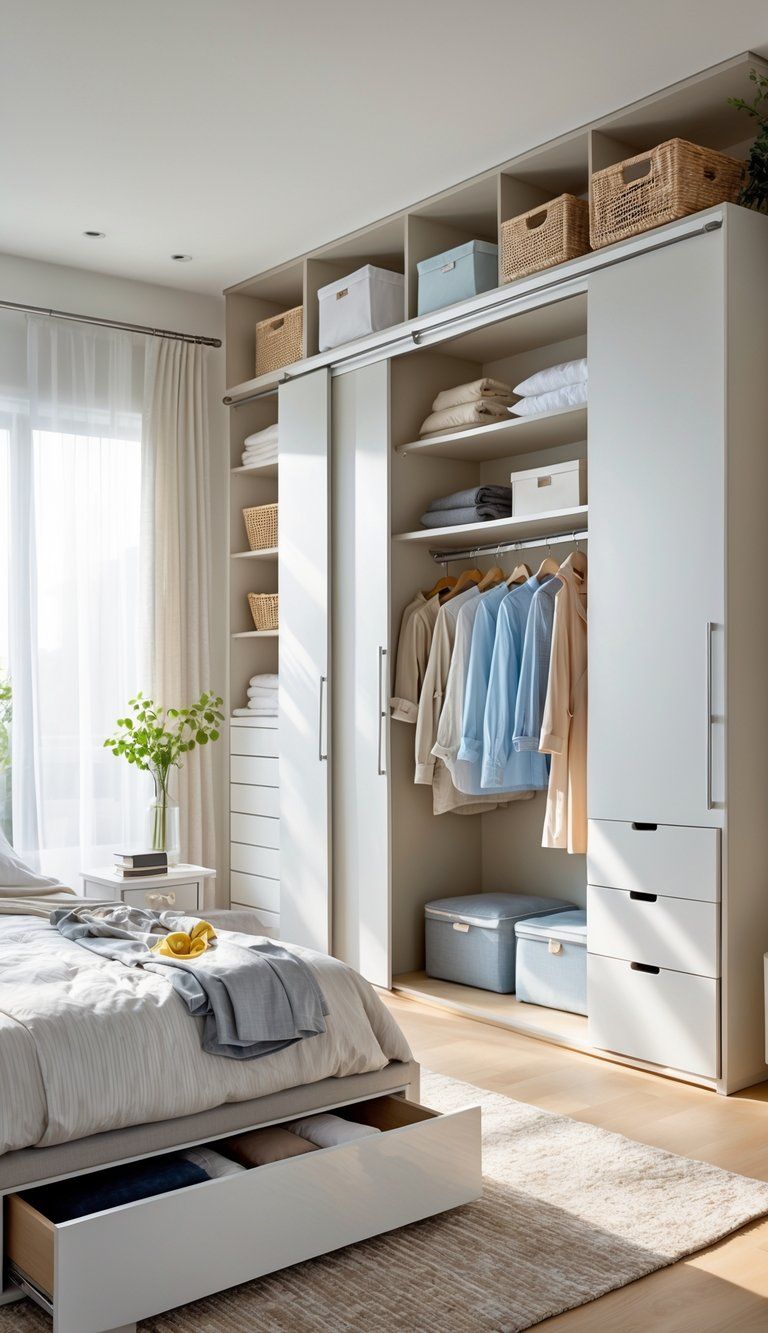
Bedrooms need clever storage to stay peaceful and uncluttered. The right setup can turn chaos into a calm retreat where everything’s in reach.
Under-Bed Solutions for Seasonal Items
The space under your bed is storage gold. Low-profile containers with wheels make it easy to grab seasonal clothes or bedding. Vacuum-sealed bags shrink bulky comforters and sweaters way down.
Some people go for under-bed drawers built right into the frame. These often have dividers to keep things sorted.
Use containers with lids to keep dust out. Label them so you don’t have to dig around every time you need something.
Under-bed storage works best for stuff you don’t use every day—think holiday decor, guest linens, or out-of-season clothes.
Incorporating Storage into Bed Frames and Nightstands
Modern bed frames can come with built-in drawers, so you don’t need an extra dresser. Platform beds with storage hold pillows, books, or electronics.
Headboards aren’t just for looks anymore. Some have shelves, hidden spots, or sliding panels for extra storage.
Floating nightstands save floor space and still keep bedside essentials close. Many have charging stations and hidden compartments for things you want nearby but not on display.
If your bedroom’s small, go for furniture that multitasks. Ottomans that open up for storage or benches at the foot of the bed with lift-up tops can hide extra blankets or pillows.
Hallway and Entryway Organization

Entryways and hallways are the first things people see. With a few smart storage tricks, you can turn these busy spots into welcoming, functional zones.
Over-the-Door Organizers and Wall-Mounted Options
Over-the-door organizers are a lifesaver for small entryways. They hang on doors and add storage without hogging floor space. You’ll find ones with different pockets for shoes, mail, or keys.
Wall-mounted shelves are another solid choice. A shelf with hooks underneath gives you a spot for decor and a place to hang coats or bags. Families can use labeled hooks so everyone knows where their stuff goes.
Pro tip: Pick wall shelves with hidden compartments for things like spare keys or leashes.
Creating Storage Nooks in Transitional Spaces
Even narrow hallways can become handy storage nooks. Check for unused corners or walls where a narrow bench with storage could fit. You’ll get a spot to sit and a place to stash shoes or bags.
Floating shelves work well in tight spots. Try different heights for more interest and storage. The open look keeps things feeling airy, not crowded.
For awkward spaces, custom cabinets can work wonders. Even a shallow cabinet, just 6-8 inches deep, can hold a lot. You could use it for:
- Keys and mail
- Drawers for gloves or scarves
- Shoe storage down low
Making the Most of Vertical Storage
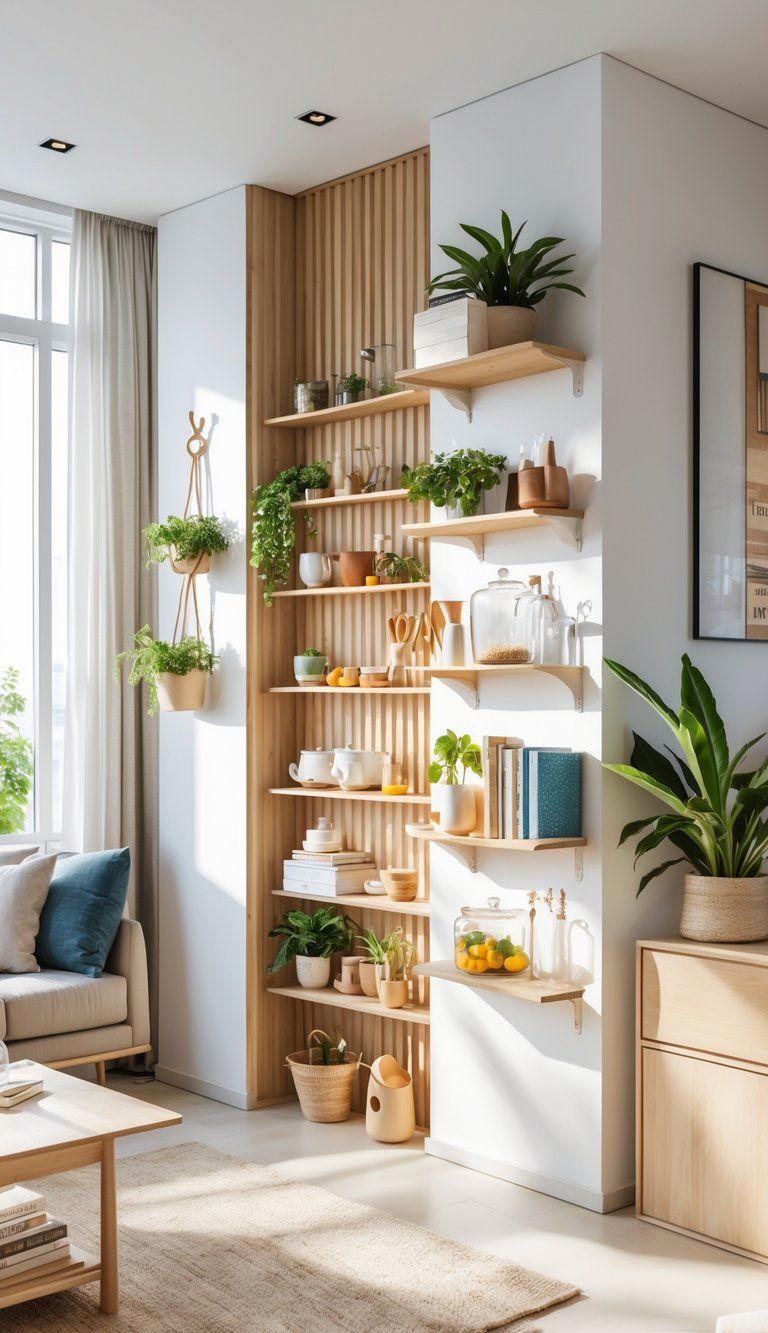
When space is tight, look up. Vertical storage uses your walls to keep things organized and frees up that precious floor space.
Installing Floating and Wall-Mounted Shelves
Floating shelves really change the game for small spaces. They add storage without bringing in bulky furniture, and you can squeeze them into weird corners where regular shelves just can’t fit.
Try putting them above doorways or windows—those spots almost always get ignored. You’ll be surprised how much extra space you can get up there.
Check the manufacturer’s instructions for weight limits before you load them up. Most floating shelves hold somewhere between 15 and 30 pounds, but it depends on how you install them and what they’re made of.
Grab a stud finder and the right anchors. You don’t want your shelves crashing down in the middle of the night!
In kitchens, wall-mounted shelves keep everyday dishes or ingredients right where you need them. Bathrooms? They’re awesome for towels and toiletries.
If you’re not thrilled about drilling lots of holes, ladder shelves might be the answer. Just lean one against the wall and use the different levels for books, plants, or whatever needs a home.
Put shelves at eye level for things you use all the time. Save the higher shelves for stuff you only need once in a while. This trick makes your mornings a little smoother.
Sliding Door and Concealed Storage Solutions
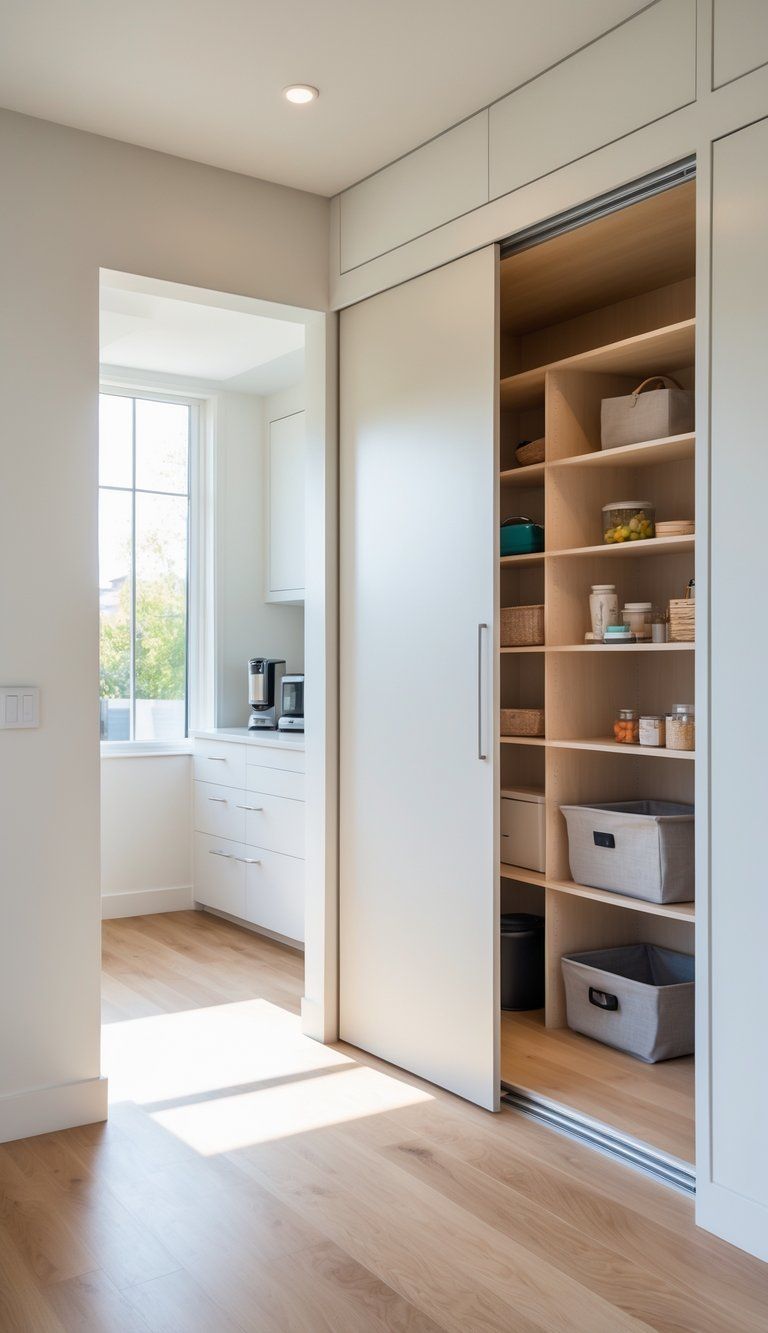
Sliding doors and hidden storage have become must-haves in homes where space is tight. These clever ideas help you use every inch while keeping things looking neat.
Installing Sliding Systems for Closets and Cabinets
Sliding door systems beat out old-school hinged doors in tight spaces. They don’t swing out, so they’re perfect for narrow hallways or small bedrooms.
You can swap them in for closet doors if you’ve got some basic DIY skills and a free weekend. For cabinets, pocket door systems like the SISO HAWA let panels slide completely out of sight. That way, you get full access to your stuff and can hide it all away when you’re done.
When you pick hardware, go for solid tracks and rollers. Cheap ones tend to stick or fall off eventually. Soft-close features are worth it—they stop slamming and help your doors last longer.
Installation tip: Double-check that your wall framing can handle the weight of the sliding system before you start.
Blending Storage with Hidden Home Decor
Hidden storage works best when it blends in with your decor. Try using false-front panels with decorative molding—they can hide storage but still look like built-ins.
Some popular ideas:
- Sliding bookcase doors that hide closets or even whole rooms
- Wall panels that slide away to show off shelving
- Under-stair drawers with handles that sit flush
Built-in storage walls with sliding panels can double as room dividers in open spaces. You can stash anything from TV gear to office supplies and still keep the room looking good.
Lately, everyone’s leaning toward custom solutions that fit their home’s style. Why settle for boring? A sliding panel could display art when it’s closed and hide storage behind it.
Embracing Smart and Innovative Storage Products
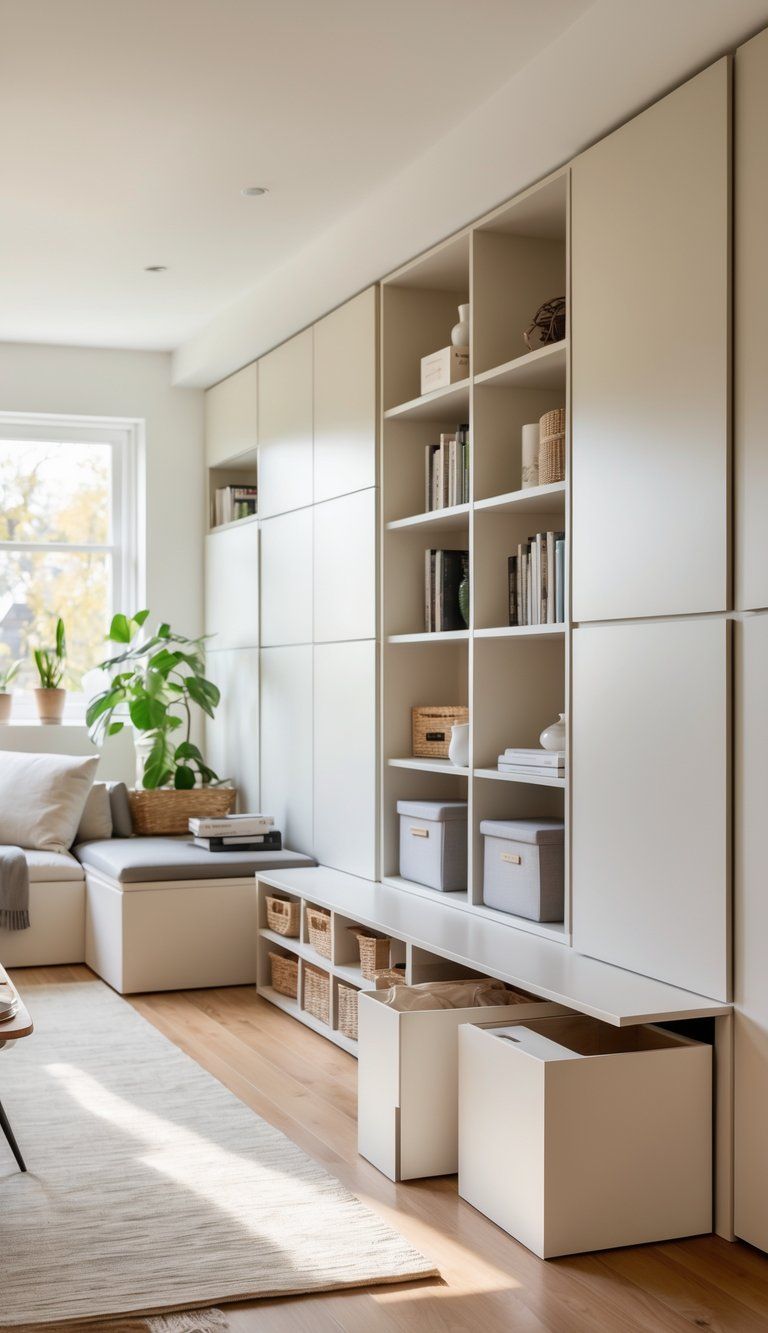
Homes these days really need storage that works for real life. Modern tech and clever design have brought us ways to make the most of our space and keep everything in order.
The Rise of Storage Technology and Modular Solutions
Smart vacuum-sealed drawers are totally changing how people store bulky stuff. The AirTight Max Drawer ($500-$900), for example, compresses comforters and winter clothes in less than 30 seconds—super handy if you live in an apartment.
The compression tech barely makes a sound, so you won’t wake up the whole place.
Pull-out pantry systems can really transform a cramped kitchen into something way more organized. These sliding units squeeze right between standard wall studs (14-16 inches wide), so you don’t lose precious living space.
Modular storage keeps getting more flexible for all sorts of homes. You’ll find setups that fit just as well in a house as in a small apartment, and they actually look pretty good.
Smart home storage devices now connect to your phone. That way, you can keep track of what you’ve got and what’s running low.
Space-saving furniture is doing double duty too. Think coffee tables with secret compartments, or beds hiding drawers underneath—why not?
Eco-friendly storage options use materials that skip the nasty chemicals and off-gassing. Some even have spots for plants, which honestly just makes your place feel nicer.

